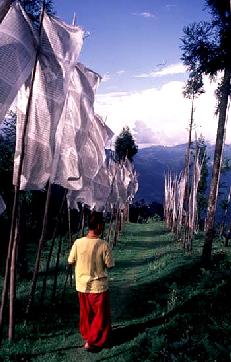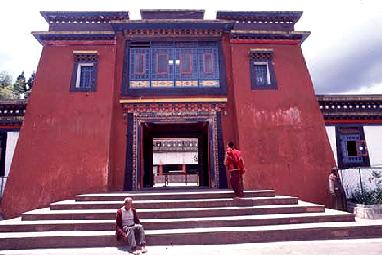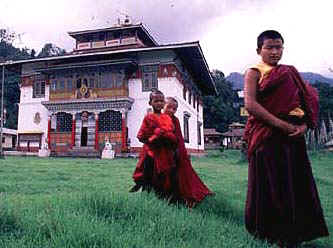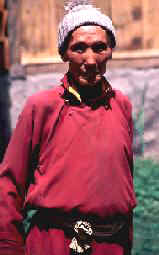Climbing the clouds to Sikkim
Steep slopes and storybook towns and temples that cling to craggy cliffs shrouded by mist makes Sikkim another of those mythical Shangri-la high in the Himalayas. Long on the list of travelers targeting the far corners of the planet, the ancient kingdom of Sikkim is opening up to tourism
By Ron Gluckman /Sikkim
W
E'RE SCALING SHEER RIDGES ABOVE THE TIBETAN PLATEAU, darting in and out of clouds to marvel at breathtaking Himalayan views. That is, when we dare look up from a succession of hairpin switchbacks, each steeper and sharper than the last, all with dizzying drops down both sides of the razor-thin mountain track.The northeastern Indian state of Sikkim, wedged in between Bhutan, Tibet and Nepal, may
be the most vertical place on the planet. Landslides plague Sikkim's precarious roads, and
that means slow going for traffic - when there is traffic. My traveling companion and I
had already spent hours on a deserted roadside - we had come upcountry for the night and
had no choice but to try and hitchhike onwards the next morning - when a road engineer
stopped his jeep to pick us up.

For the next hour, we bump and wiggle, snaking no more 12 kilometers. Suddenly, at a sharp
bend, we come to a halt at the sound of chanting. For kilometers the countryside has shown
no sign of habitation, but here, on a grassy ledge at the edge of a vast gorge, a
surreal scene is staged. An old Buddhist monk intones prayers in a haze of incense.
Maroon-robed disciples bang drums, shake bells and toss rice into the wind. Without a word
of explanation, the engineer steps from the jeep and soon is sipping tea and sharing
stories in a rapturous mix of Nepalese, Tibetan, Hindi and hill dialects.
In Sikkim, surprise is more common than speed. Likewise tradition, hospitality and
ceremony, which seem to roam like free spirits along the fabled "rooftop of the
world."
Sikkim has long been classified with all the other mythical Shangri-las in this heavenly region. It certainly qualifies. Sikkim's steep slopes are striped with rice terraces, tea plantations or cardamom, the major crop. Temples and fairytale towns are tacked onto the faces of sheer cliffs throughout a craggy kingdom running up and down magnificent ridges. And the people are as colorful a mix as the terrain: Nepalese, Tibetan, Bhutanese, Hindi and numerous hill tribes.
Here, near the top of the world, visitors cannot help but feel special. Everest is visible just beyond Sikkim's own Mount Kanchendzonga, a circus tent of snow-capped peaks including the third highest in the world. In the clear, mountain air, Tibet seems so close you can smell the Yak butter tea. Bhutan is just miles away. But Sikkim offers one thing its celebrated neighbors cannot: free and easy access.
It hasn’t always been so. For centuries, this ancient kingdom was locked up, an utter recluse. Even after joining India - its 25th anniversary was celebrated in May 1999, although statehood actually started in 1975 - Sikkim remained a prime target of travelers seeking the far corners of the planet. Sikkim certainly fit the bill. Permits for foreigners were rarely approved, and then only for a day or two. Beginning this year, most of the state opened to tourism. Permits are still required, but a 15-day entry pass is free for the asking. Yet, the word is slowly circulating. Only 10,000 non-Indian visitors reach Sikkim each year; ultra-exclusive Bhutan receives 6,200 foreign tourists annually. But Bhutan is costly, with mandatory group tours running to US$200 per day. In contrast, Sikkim is a poor-man's Bhutan, offering untrammeled forests to trek and lots of Tibetan temples. Backpackers boast of US$10-a-day budgets. Accommodation is basic outside of the biggest towns, but a little money sure stretches a long way here.
Sikkim is quite a contrast from the rest of India. The climate can be chilly, but the people are friendly and the pace is relaxing. When we started our journey in Calcutta, people were dying in a severe heatwave, but it was cool in Sikkim. After a comfortable overnight train from Calcutta to Siliguri, the nearest rail station, we hired a jeep for the three-hour climb, almost 90-degrees straight up, to the state capital of Gangtok.
India's smallest state not much bigger than America's Rhode Island, or the island of
Bali. But that's a flat measure; Sikkim is anything but. You'd be hard-pressed to find a
square meter of level ground within Sikkim's entire 7,100 square kilometers., "From
the air, it looks as though a giant plough had been carelessly run through it,"
writes Rajesh Verma, a local policeman who has produced perhaps the first guide to Sikkim.
"Traveling on these roads gives you the feeling of riding on a horse that has gone
berserk."
Gangtok stands at 1,700 meters, sprawling defiantly across a ridge overlooking a drop nearly as deep. Gangtok means Lofty Hill, an apt moniker. Sights include Rhumtek Monastery (a replica of Chhofuk in Tibet) and the Namgyalk Institute of Tibetology, where the Dalai Lama laid the foundation stone in 1957. In spring, rhododendron color Sikkim's slopes, while its gardens are abloom with hundreds of varieties of orchids in spring and fall. Gangtok's market is equally colorful, showcasing the capital's population melting pot: tribal weavers, Indians with overflowing barrels of fragrant spice, Sikkimese tea and cardamom, and the sparkle of Nepalese silver spread on sarongs.
Sikkim has more than 250 monasteries. In truth, few match the majesty of those in Tibet or Bhutan. But there is a refreshing lack of commercialization to tourism here. One can trek to mountaintop temples and stroll past prayer flags fluttering in the breeze to spend hours alone, enchanted by chanting and smell of incense. We did just that after journeying to Phodong, a tiny North Sikkimese settlement where the three small lodges were unexpectedly booked up. No problem. Pema Liaden's son was away, so the owner of Hotel Yak and Yeti simply removed her son's belongings and rented us the double room, overlooking dazzling rice terraces, for US$4. Simple meals from her kitchen for two cost about the same.
From Phodong, there are no tour buses to the temples. That's part of the pleasure. Along the road, old men wave for you to stop, not to sell trinkets, but to admire their recently-capped teeth. A row of flags lead up a steep path to Phodong Monastery, where a bespectacled monk leads Buddhist chants, while several novices bang on drums. Nobody breaks rhythm for the rare visitor.
Further on, the dirt trail winds a few kilometers into richly-forested hills. Children
materialize to guide us along rickety wooden steps, through a neat and trim village, to
the hidden Labrang Monastery. This is a true gem, parked on a green plateau, overlooking
miles of nothing but snow-capped peaks and verdant hills that stretch to the very horizon.
A young monk notes our approach, running away madly, returning out of breath minutes
later. Smiling, he produces a key to the small temple. 
At Labrang, like temples around Sikkim, there is no gate. There are also no ticket booths, tour buses, nor stands selling souvenirs. Inside Labrang temple, there isn't even an offering box. Thanks seems payment enough.
Nevertheless, the tourism machine is beginning to roll in Sikkim. A hint of what is on the way can be seen in Pelling, a mountain town wrapped in the mist of western Sikkim. New hotels clutter the outpost and cement pilings attest to a tourism boom on the horizon. "We want to do more promotion now that Sikkim is opening up," says Surendra Pradhan, managing director of Siniolchu Tours, and the general secretary of the Travel Agents Association of Sikkim. "The more business, the better."
Sikkimese are understandably anxious for development, and the world will doubtlessly comply. Expect wider roads for busloads of wide-eyed tourists who will book guided treks to remote monasteries, where they will swoon at the sight of unfettered Tibetan worship. In a way, it's ironic. Condemnation of China's takeover of Tibet has become a trendy global concern. Yet nobody gripes about assimilation in Sikkim, where hill children no longer speak their own tongues. Hindi and Nepalese are taught in school. And massive migration from Nepal and Bengal has reduced the native population, mainly Lepchas, to under 20 percent of Sikkim's population of 425,000 people. The Limbus and the Bhutias, other notable tribes, are actually of Tibetan descent. Perhaps most ironic of all, they escaped religious persecution back home, where Sikkim's Red Hat Sect was driven out by the Yellow Sect, the same Tibetan Buddhists now in vogue.
Sikkim itself simmers somewhat. "The immigrants from India take all the
jobs," says a clothing vendor at Lal Bazar in Gangtok. "And the Nepalese bring
all the trouble." But few regret joining India, a marked contrast from sentiment in
Tibet. That's a consequence of self-determination. Over 95 percent of voters supported
statehood and an end to centuries of rule by the Sikkimese monarchy.
Since then, India has poured scarce government funding into the region, mainly because of military concerns. China still does not recognize India's rule of Sikkim and the surrounding area is rife with autonomy chatter. Not in Sikkim, which enjoys tax-free status and some odd industries. Travel brochures tout Swiss mountains and alpine lakes, and Sikkim, like Switzerland, also produces timepieces.
These could be souvenirs for a new generation of tourists. Already lines can be seen in Gangtok for jeep tours to distant lakes along the border, where special group passes are needed. Still, nothing stops an intrepid traveler from hopping into one of the rickety land cruisers that pass for public transport around Sikkim. Expect to average 20-30 kilometers per hour - if there are no landslides.
Still, there's no need to rush. Sikkim is a place for studied slowness, with rewards
often coming during the journey rather than at the stated
destination. That's the spirit that took us to Phodong one night, far from civilization
with no means for returning to Gangtok.
But the engineer came to our rescue, and driving slowly back to Gangtok, we found our
reward waiting on the winding mountain road.
After stopping at the sound of chanting, we joined the engineer and the monk on the
mountain terrace, where we were served fragrant tea while savoring the incense and views.
Only later did we learn the occasion. This was a typical Buddhist one-year ceremony, with
elements of native spirituality blended in. A year before, another official had been
traveling this same road, in a similar jeep. It plunged off the road where the monk sat.
There were no survivors.
"They weren't lucky," the engineer tells us.
But, braving the long and winding roads in Sikkim, we were.
Some tips for travelers:
Documents: Foreigners must have a permit stamped in their passport, which is free for the
asking when you get your Indian visa. This 15-day permit can be extended at the Tourist
Information Office in Gangtok, which also issues access permits for the latest parts of
Sikkim opening up.
Transportation: There are no airports or railroads in Sikkim, and only one road connecting
the state to the rest of India. Most visitors take trains or buses to either Siliguri or
Darjeeling, and then take a jeep to Gangtok. Shared jeeps cost $3 to $4, or an entire jeep
can be hired for $20 to $25 for the three- to four-hour ride. There are also flights from
Calcutta and New Delhi direct to Bagdogra airport, outside Siliguri.
Lodging: Hotels can be booked upon arrival in any Sikkimese town. Information is readily
available in Gangtok at the government tourist
office. In Gangtok, the top hotel is the Hotel Tashi Delek (Tel: (03592) 22991; Fax:
22362; rooms $60 and up), but scores of lodges and guesthouses dot every ridge road. One
standout is the Hotel Sonam Delek (Tel: 22566, 24025; Fax: 23197), where rooms with
arguably the best views in town go for $13.
Food: While the food is essentially the same as much of India, Sikkim also boasts the
added delicacies of Tibetan, Nepalese and Bhutanese cuisine. In Gangtok, expect to pay no
more than $10 to $15 for two in a variety of exotic eateries such as the Blue Sheep
Restaurant (specialties include the sizzling platters). Hotel restaurants are also good
value, particularly the Snow Lion at the Tibet Hotel (a meal of marvelous Indian and
regional dishes runs about $10 for two), and the Oyster Restaurant at the Hotel Sonam
Delek (all regional cuisines, plus Italian, for about $10 for two).
Ron Gluckman is an American reporter who is based in Hong Kong, but who roams around Asia for a number of publications, including the Asian Wall Street Journal, which ran this piece in August 1999.
To return to the opening page and index
push here
[right.htm]
